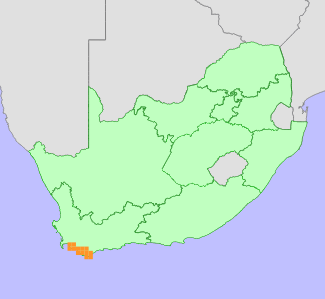|
Scientific Name | Protea compacta R.Br. |
Higher Classification | Dicotyledons |
Family | PROTEACEAE |
Synonyms | Protea triandra Schltr. |
Common Names | Bot River Protea (e), Bot River Sugarbush (e), Botrivier-suikerbos (a), Suikerbos (a), Suikerkan (a) |
National Status |
Status and Criteria | Least Concern |
Assessment Date | 2020/07/28 |
Assessor(s) | A.G. Rebelo, H. Mtshali & D. Raimondo |
Justification | Protea compacta is a range-restricted species, with an extent of occurrence (EOO) of 4122-4148 km², and an area of occupancy (AOO) of 1032-1040 km². It is a popular species for the cut-flower industry and there has been extensive augmentation of subpopulations through the practise of broadcasting seeds. Many extensive subpopulations remain extant and this species is not in danger of extinction and is therefore listed as Least Concern. |
Distribution |
Endemism | South African endemic |
Provincial distribution | Western Cape |
Range | It is endemic to the south Western Cape, South Africa, where it occurs from Betty's Bay to the Bredasdorp Mountains. |
Habitat and Ecology |
Major system | Terrestrial |
Major habitats | Overberg Dune Strandveld, Overberg Sandstone Fynbos, Kogelberg Sandstone Fynbos, Elim Ferricrete Fynbos, Agulhas Sand Fynbos, Hangklip Sand Fynbos |
Description | This species grows on lowland sandstone fynbos and sandy coastal flats, 0-200 m. Mature individuals are killed by fires, and only seeds survive. Wind-dispersed seeds are stored in fire-resistant inflorescences, and released after fires. It is pollinated by birds. |
Threats |
| At least 31% of this species' habitat is irreversibly modified, predominantly due to habitat loss to coastal housing development and agriculture (protea orchards and vines) expansions, and this loss continues (3% habitat loss recorded between 1990 and 2014).
The most significant threats to this species include: competition from alien invasive plants (hakea, acacias and pines); loss of habitat to sand mining; intensive commercial harvesting for the cut-flower industry in some parts of its range; and inappropriate fire management on the Elim and Agulhas flats.
Since this species is popular both as a cut-flower and in the dried-flower industry, it has been extensively planted both in protea orchards and broadcast sown within burned and bush cut vegetation. No known genetic manipulation or cultivar selection is apparent within its distribution range. However, hybridization with orchard plants is likely to be a threat. |
Population |
Protea compacta is locally common, and subpopulations are large, consisting of thousands of individuals. The population is stable or increasing due to extensive broadcasting of seeds to augment populations for the cut-flower industry.
|
Population trend | Decreasing |
Conservation |
| It is conserved in the Kogelberg, Houwhoek, and Fernkloof Nature Reserves and Groot Hagelkraal and Brandfontein-Rietfontein Private Nature Reserves. |
Assessment History |
Taxon assessed |
Status and Criteria |
Citation/Red List version | | Protea compacta R.Br. | NT A2c+4d | Raimondo et al. (2009) | |
Bibliography |
Goldblatt, P. and Manning, J.C. 2000. Cape Plants: A conspectus of the Cape Flora of South Africa. Strelitzia 9. National Botanical Institute, Cape Town.
Manning, J.C. and Goldblatt, P. 2012. Plants of the Greater Cape Floristic Region 1: The Core Cape Flora. Strelitzia 29. South African National Biodiversity Institute, Pretoria.
Raimondo, D., von Staden, L., Foden, W., Victor, J.E., Helme, N.A., Turner, R.C., Kamundi, D.A. and Manyama, P.A. 2009. Red List of South African Plants. Strelitzia 25. South African National Biodiversity Institute, Pretoria.
Rebelo, T. 2001. Sasol Proteas: A field guide to the proteas of southern Africa. (2nd ed.). Fernwood Press, Vlaeberg, Cape Town.
|
Citation |
| Rebelo, A.G., Mtshali, H. & Raimondo, D. 2020. Protea compacta R.Br. National Assessment: Red List of South African Plants version . Accessed on 2025/07/06 |
 Comment on this assessment
Comment on this assessment

